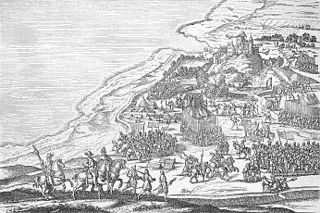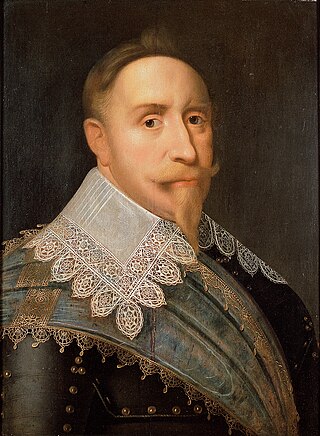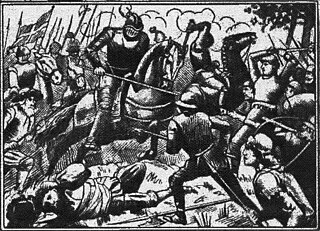
Axel Gustafsson Oxenstierna was a Swedish statesman and Count of Södermöre. He became a member of the Swedish Privy Council in 1609 and served as Lord High Chancellor of Sweden from 1612 until his death. He was a confidant of King Gustavus Adolphus and then Queen Christina, for whom he was at first regent.

Christian IV was King of Denmark and Norway and Duke of Holstein and Schleswig from 1588 until his death in 1648. His reign of 59 years and 330 days is the longest in Scandinavian history.
During the 17th century, despite having scarcely more than 1 million inhabitants, Sweden emerged to have greater foreign influence, after winning wars against Denmark–Norway, the Holy Roman Empire, Russia, and the Polish–Lithuanian Commonwealth. Its contributions during the Thirty Years' War under Gustavus Adolphus helped determine the political, as well as the religious, balance of power in Europe.

The Second Treaty of Brömsebro was signed on 13 August 1645, and ended the Torstenson War, a local conflict that began in 1643 between Sweden and Denmark–Norway. Negotiations for the treaty began in February the same year.

The Treaty of Knäred was signed on 21 January 1613 and ended the Kalmar War (1611–1613) between Denmark-Norway and Sweden. The peace negotiations came about under an English initiative. The peace was guaranteed by King James I of England and VI of Scotland.

The Battle of Colberger Heide took place on 1 July 1644 during the Torstenson War, off the coast of Schleswig-Holstein. The battle was indecisive, but a minor success for the Dano-Norwegian fleet commanded by Jørgen Vind, assisted by Grabow and King Christian IV, over a Swedish fleet commanded by Klas Fleming, assisted by Ulfsparre and Bjelkenstjerna.

The Northern Seven Years' War was fought between the Kingdom of Sweden and a coalition of Denmark–Norway, Lübeck, and Poland–Lithuania between 1563 and 1570. The war was motivated by the dissatisfaction of King Frederick II of Denmark with the dissolution of the Kalmar Union, and the will of King Eric XIV of Sweden to break Denmark's dominating position. The fighting continued until both armies had been exhausted, and many men died. The resulting Treaty of Stettin was a stalemate, with neither party gaining any new territory.

The Torstenson War was fought between Sweden and Denmark–Norway from 1643 to 1645. The name derives from Swedish general Lennart Torstenson.
The Military timeline of Denmark is centered around an involvement in wars in Northern Europe since 793 and, recently, elsewhere.

Kristianopel is a village in Karlskrona Municipality in the southeastern Swedish region of Blekinge. In 2015 it had a population of 88.

Denmark–Norway is a term for the 16th-to-19th-century multi-national and multi-lingual real union consisting of the Kingdom of Denmark, the Kingdom of Norway, the Duchy of Schleswig, and the Duchy of Holstein. The state also claimed sovereignty over three historical peoples: Frisians, Gutes and Wends. Denmark–Norway had several colonies, namely the Danish Gold Coast, Danish India, and the Danish West Indies. The union was also known as the Dano-Norwegian Realm, Twin Realms (Tvillingerigerne) or the Oldenburg Monarchy (Oldenburg-monarkiet).
The military history of Norway commences before the Viking Age with the internal wars fought between regional kings to obtain the supreme kingship of the whole of Norway. The most famous period of Norwegian history and thus military history is the Viking Age, but the early Middle Ages was the era when Norwegian military power in Europe reached its peak. Since then the Norwegian military has experienced long periods of neglect, but also rearmament and victories.

The establishment of a dominium maris baltici was one of the primary political aims of the Danish and Swedish kingdoms in the late medieval and early modern eras. Throughout the Northern Wars the Danish and Swedish navies played a secondary role, as the dominium was contested through control of key coasts by land warfare.

The Jämtland Campaigns of 1808–1809 were two Dano-Norwegian military campaigns into the Swedish province of Jämtland during the Dano-Swedish War of 1808-1809.
From 1611 to 1721, Sweden was a European great power, becoming a dominant faction in the quest for control of the Baltic Sea and a formidable military power. During this period, known as Stormaktstiden, the Swedish Empire held a territory more than twice the size of its modern borders and one of the most successful military forces at the time, proving itself on numerous occasions on battlefields such as Wallhof, Narva, and Düna. The military of the Swedish empire is commonly recognized only as the Caroleans, which were in fact not in service until the late 17th century under Charles XI and his successor. The Swedish Empire and its modern military force was founded by Gustavus Adolphus, who inherited the throne in 1611 at age 17. He immediately reformed the common European military based on mercenaries to a professional national army. However, before completing his vision of conquering the Holy Roman Empire, the warrior king was killed in action in 1632. His daughter and successor did little to improve Sweden's military position and abdicated early, providing the Swedish Empire with a more warlike ruler. Charles X Gustav was only king for 5 years, but conquered large amounts of territory that still belong to Sweden today. His son Karl XI would further strengthen the army by introducing the Caroleans, which were also used by Karl XII in the Great Northern War.

Gustavus Adolphus, also known in English as Gustav II Adolf or Gustav II Adolph, was King of Sweden from 1611 to 1632, and is credited with the rise of Sweden as a great European power. During his reign, Sweden became one of the primary military forces in Europe during the Thirty Years' War, helping to determine the political and religious balance of power in Europe. He was formally and posthumously given the name Gustavus Adolphus the Great by the Riksdag of the Estates in 1634.

The Dano-Swedish War from 1501 to 1512 was a military conflict between Denmark and Sweden within the Kalmar Union.
The Storming of Kristianopel occurred on 26 June 1611, during the Kalmar War. Gustavus Adolphus of Sweden led an assault from the camp in Högsby in Småland on Kristianopel in Blekinge. The Swedes managed to siege the fortified city and went in by bombing the fortress port, which was badly defended. Right after the assault, there was a massacre of the city's population, with rape and pillaging.

Gustavus Adolphus' reconquest of Öland occurred from 26 or 27 September to 8 October 1611 during the Kalmar War.

The Assault on Gullberg Castle occurred on 26 January 1612 during the Kalmar War. The female commander of the fortress, Emerentia Krakow, successfully lead the Swedish defense after her husband, Mårten Krakow, broke his leg after falling off his horse.















